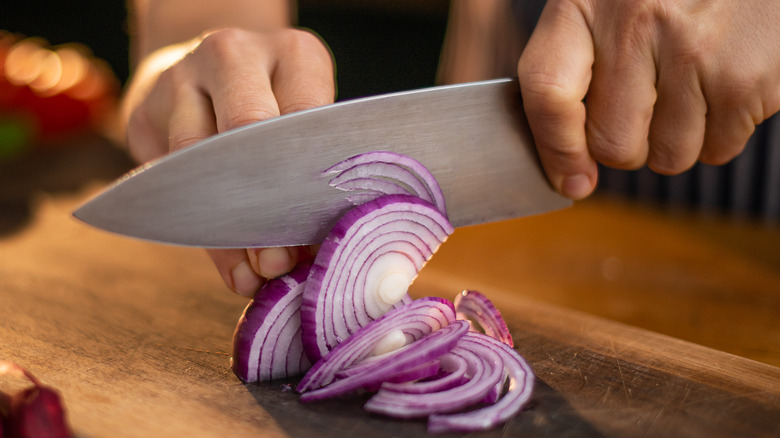In the world of culinary arts, the choice of knives can significantly impact the quality of food preparation. For kitchen professionals, understanding the intricacies of German knife edge geometry is essential to mastering precision and efficiency. This article dives deep into the significance of German knife design, shedding light on why it remains a preferred choice for many chefs.

The Artistry Behind German Knife Edge Geometry
German knives are renowned for their robust build and exceptional sharpness. The edge geometry of these knives is a pivotal factor that contributes to their performance. When we speak of German knife edge geometry, we're referring to the specific shape and angle of the blade's edge, which determines how the knife cuts, slices, and dices.
Typically, German knives feature a blade angle of around 20 degrees. This angle strikes a balance between sharpness and durability, allowing the blade to retain its edge longer while offering a precise cut. The slightly curved edge also facilitates a rocking motion, making it ideal for chopping herbs or vegetables swiftly.
How German Knife Geometry Enhances Kitchen Efficiency
For any kitchen professional, efficiency is key. The geometry of German knives enhances this by offering a versatile tool that can handle various cutting tasks. The full tang design, where the blade runs through the handle, provides greater control and balance, which is crucial for executing precise cuts with minimal effort.
Moreover, the robust nature of German knives means they can withstand heavier tasks, such as cutting through meat or bones, without compromising the blade's integrity. This versatility makes them a staple in both home kitchens and professional culinary settings.
Comparing German and Japanese Knife Geometries
While German knives boast a broader edge angle, Japanese knives often feature a more acute angle, around 15 degrees, resulting in a sharper but more delicate edge. This distinction is crucial for kitchen professionals to understand, as it influences the knife's application. German knives are better suited for tasks requiring durability, while Japanese knives excel in precision and finesse.
Applications in Professional Kitchens
In professional kitchens, the choice of knife can be a decisive factor in the outcome of a dish. German knives, with their balanced edge geometry, are ideal for tasks that require both power and precision. Chefs often rely on them for chopping, dicing, and even butchering. For more specific tasks, such as filleting fish or slicing delicate ingredients, a Japanese knife might be preferred.
Understanding these differences allows chefs to choose the right tool for the job, enhancing both efficiency and the quality of their culinary creations. For more insights into selecting the best tools for your kitchen, check out this article on the best German knife set.
Maintaining the Edge: Care Tips for German Knives
To maintain the performance of German knives, regular honing and sharpening are essential. Honing aligns the blade's edge, while sharpening restores its angle. Using the right cutting surface is also crucial. Opt for a wooden or plastic cutting board, as these materials are gentler on the knife's edge. For more information on choosing the right cutting board, visit this guide.
Storing and Handling
Proper storage is vital to preserve the edge geometry of German knives. A magnetic strip or knife block is recommended to avoid contact with other utensils, which can dull the blade. Additionally, handling the knife with care, using a firm grip, and avoiding dishwasher cleaning can prolong its lifespan.
For more safety tips on handling these knives, explore this comprehensive article on German knife safety.
The Legacy of German Knife Craftsmanship
The principles of German knife edge geometry are deeply rooted in a tradition of craftsmanship that dates back centuries. Solingen, a city in Germany, is known as the 'City of Blades' and has been at the forefront of knife production. This rich history has led to the development of knives that are not only functional but also works of art. To learn more about the historical significance of German knives, visit this external source.
Why Choose German Knives?
For kitchen professionals, choosing a German knife is an investment in quality and reliability. The edge geometry, combined with superior materials and craftsmanship, ensures that these knives perform consistently over time. Whether you're a seasoned chef or an aspiring culinary artist, understanding the nuances of German knife edge geometry can elevate your cooking experience.

FAQs about German Knife Edge Geometry
What is the typical angle of a German knife edge?
German knives usually have a blade angle of around 20 degrees, providing a balance between sharpness and durability.
How does German knife geometry differ from Japanese knives?
German knives have a broader edge angle, making them more durable, while Japanese knives feature a more acute angle, offering sharper but more delicate edges.
What maintenance is required for German knives?
Regular honing and sharpening are essential to maintain the edge. Proper storage and handling, along with using appropriate cutting boards, can also help preserve the knife's performance.


























